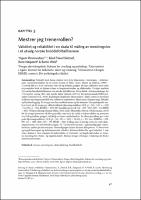Chapter 3 Mestrer jeg trenerrollen?
| dc.contributor.author | Ommundsen, Yngvar | |
| dc.contributor.author | Solstad, Bård Erlend | |
| dc.contributor.author | Høigaard, Rune | |
| dc.contributor.author | Wold, Bente | |
| dc.contributor.author | Ommundsen, Yngvar | |
| dc.contributor.author | Erlend Solstad, Bård | |
| dc.contributor.author | Høigaard, Rune | |
| dc.contributor.author | Wold, Bente | |
| dc.date.accessioned | 2018-07-27 11:59:03 | |
| dc.date.accessioned | 2020-04-01T12:33:31Z | |
| dc.date.available | 2020-04-01T12:33:31Z | |
| dc.date.issued | 2018 | |
| dc.identifier | 1000330 | |
| dc.identifier | OCN: 1076646308 | en_US |
| dc.identifier.uri | http://library.oapen.org/handle/20.500.12657/29602 | |
| dc.description.abstract | "The purpose of this study was to examine factorial, convergent, discriminant, and criteria validity of a multi-dimensional scale measuring coaching efficacy (Feltz, Chase, Moritz, & Sullivan, 1999). The sample consisted of 281 Norwegian grassroot football coaches taking part in two data collections (across the football season) within the Norwegian arm of the international PAPA project (intervention group, n = 193) and control group, n = 88). Latent variable modeling supported a 4-factor model reflecting Motivation efficacy, Strategy efficacy, Technique efficacy and Character efficacy. An introductory ESEM analysis of the 24-item coaching efficacy scale yielded an acceptable solution after omitting two items. A parceling approach of the twenty-two items were then converted into eleven parcels to examine factorial validity and time and group invariance. The four-factor model based on parcels obtained good fit indices: (S-B χ2 = [df = 29, n = 222] = 38.622, p < .011 (ns.); RMSEA = .039; 90% (CI = .000–.068); CFI = .99; SRMR = .023). Moreover, we obtained strong support for time invariance for a merged solution of the two groups of coaches. Invariance across time for the intervention and control group separately was supported at time 1, but not at time 2. Satisfactorily convergent, discriminant, and criteria validity were also supported. The scale needs further validation before use in intervention studies." | |
| dc.language | Norwegian | |
| dc.subject.classification | thema EDItEUR::J Society and Social Sciences::JM Psychology | en_US |
| dc.subject.other | coaching efficacy | |
| dc.subject.other | scale validation | |
| dc.subject.other | grassroot football | |
| dc.subject.other | treneres mestringstro | |
| dc.subject.other | skalavalidering | |
| dc.subject.other | breddefotball | |
| dc.title | Chapter 3 Mestrer jeg trenerrollen? | |
| dc.type | chapter | |
| oapen.abstract.otherlanguage | "Formålet med denne studien var å teste dimensjons-, konvergens -, diskriminant- og kriterievaliditet for en norsk versjon av Feltz, Chase, Moritz og Sullivan (1999) – Coaching Efficacy Scale. Invarians over tid og mellom grupper ble også inkludert med tanke på prospektiv bruk av skalaen i form av lengdesnittstudier og effektstudier. Utvalget omfattet 281 norske breddefotballtrenere i tre norske fotballkretser. Disse deltok i datainnsamlinger før (T1) og etter sesong (T2) i den norske delen (Solstad, 2017) av det internasjonale PAPA-prosjektet (Quested et al., 2013). Innledende eksplorativ faktoranalyse i Mplus støttet en forventet 4-faktors mestringstromodell som reflekterte henholdsvis: Motivasjon, Kampstrategi, Teknikk og Karakterbygging. To utsagn viste høy residualvarians og ble eliminert. En oppfølgende analyse basert på 22 utsagn gav tilfredsstillende tilpasningsindekser (S-B χ2 = [df = 149, n = 222] = 312.901, p < .001; RMSEA = .070; 90% konfidensintervall (CI = .059–.081); CFI = .94; SRMR = .025). Ved parselleringsteknikk (Kline, 2011; Little, Rhemtulla, Gibson, & Schoemann, 2013) ble 22 utsagn konvertert til elleve parseller som basis for sjekk av faktorvaliditet og invarians over tid og mellom grupper ved hjelp av latent variabelanalyse. De elleve parsellene gav svært gode tilpasningsindekser; (S-B χ2 = [df = 29, n = 222] = 38.622, p < .011 (ns.); RMSEA = .039; 90% (CI = .000–.068); CFI = .99; SRMR = .023). I tillegg fant vi entydig støtte for sterk skaleringsinvarians over tid (fotballsesongen; T1–T2) for intervensjons- og kontrollgruppe samlet. Invarians splittet på intervensjons-/kontrollgruppe kunne derimot ikke påvises. Vi observerte også god konvergent og diskriminerende validitet. Kriterievaliditet ble også bekreftet. I sum synes skalaen å være velegnet til undersøkelse av tverrsnitt- og lengdesnittstudier av treneres mestringstro i barne- og ungdomsidrett. Skalaen trenger ytterligere validering før bruk i intervensjonsstudier." | |
| oapen.identifier.doi | 10.23865/noasp.39.ch3 | |
| oapen.relation.isPublishedBy | bf7b42a4-6892-42e3-aaf8-8f32c8470a8b | |
| oapen.relation.isPartOfBook | 387ce5c2-7055-4af1-99b5-973279fb12bb | |
| oapen.relation.isbn | 9788202596903 | |
| oapen.pages | 26 | |
| oapen.place.publication | Oslo | |
| oapen.identifier.ocn | 1076646308 |

